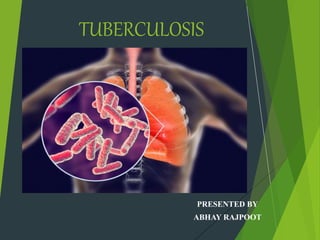
Tuberculosis
- 2. DEFINITION It is infectious disease caused by Mycobacterium tuberculosis and characterized by the formation of tubercles (round nodules) or granulomas in lungs. It may be transmitted to other body parts such as meningitis, bones, kidneys, lymph nodes.
- 3. Latent TB - the bacteria remain in the body in an inactive state. They cause no symptoms and are not contagious, but they can become active. Active TB - the bacteria do cause symptoms and can be transmitted to others.
- 5. Global India Incidence 1,04,00,000 (140/lakh) 27,90,000 (211/lakh) Deaths 16,74,000 (22/lakh) 4,35,000 (33/lakh) HIV TB cases 10,30,000 (14/lakh) 87,000 (6.6/lakh) HIV TB deaths 3,74,000 (5.0/lakh) 12,000 (0.9/lakh) Estimated MDR/RR cases 6,01,000 (8.1/lakh population) 1,47,000 (11/ lakh population) Global TB Burden -2017
- 6. INCIDENCE Tuberculosis (TB) remains the world's deadliest infectious disease although global efforts have averted an estimated 54 million tuberculosis (TB) deaths since 2000, the World Health Organization (WHO) warned on Tuesday. WHO, in its latest 2018 Global TB Report, says countries are still not doing enough to end TB by 2030 and calls for an unprecedented mobilization of national and international commitments.
- 9. TRANSMISSION
- 10. PATHOPHYSIOLOGY
- 12. DIAGNOSTIC EVALUATION History collection Physical examination Sputum test Blood test
- 13. Mantoux test
- 14. CHEST X-RAY
- 15. COMPLICATIONS • Meningitis • Spinal pain. • Joint damage. • Damage to the liver or kidneys • Heart disorders
- 16. MANAGEMENT
- 17. Directly Observation Treatment Shortcourse Why? Many patient don’t take medicine regularly ,even if excellent health education provided. Who? All patient…impossible to predict which patient will take medicine(1/3 not adherent). What? Observer watches and helps patient swallow tablets. Where? Anywhere (home, clinic, work, school etc). Who does it? HCW, community workers , teacher. Direct observation ensure treatment for entire course with the right drugs, in the right dose, at the right intervals.
- 18. ANTI TUBERCULAR DRUGS FIRST LINE DRUGS Isoniazid (H) Rifampicin(R) Pyrazinamide(Z) Ethambutol(E) Streptomycin(S)
- 20. SECOND LINE DRUGS Thioacetazone PASA Ethionamide Cycloserine Kanamycin Capreomycin Amikacin
- 23. ` Category Type of patient Regimen Duration in months Test at month Category I COLOR OF BOX: RED New sputum smear positive New sputum smear negative New extra pulmonary New others 2(HRZE)3 4(HR)3 6 2 Category II COLOR OF BOX:BLUE Sputum positive relapse Sputum positive failure After default 2(HRZES)3 1(HRZE)3 5(HRE)3 8 3 Category III COLOR OF BOX:GREEN Sputum negative, Extra pulmonary not seriously ill 2(HRZ)3 4(HR)3 6
- 25. Adverse reactions to anti-T.B drugsDrugs Adverse effects •Isoniazid Peripheral neuropathy Hepatitis •Rifampicin Vomiting, abdominal pain hepatitis •Pyrazinamide Joint pain, hepatitis •Ethambutol Optic neuritis •Streptomycin Renal damage Auditory & vestibular nerve damage
- 26. OTHER MANAGEMENT STRATEGIES Nutritional therapy Lifestyle modification Cough hygiene Regular follow up Prevention of complications
- 27. ROLE OF NURSE NURSES ARE THE BACKBONE OF TB CONTROL NURSES EXIST GLOBALLY AND SHARE COMMON IDEAS AND VALUES
- 28. KEY ACTIVITIES OF NURSES PATIENT CARE HEALTH EDUCATION TREATMENT OBSERVATION SPUTUM COLLECTION MANAGEMENT/ COORDINATION CONTACT TRACING/ SCREENING RESEARCH TEACHING
- 29. NURSES AND CASE DETECTION: • First point to call in primary care services • Health education • Holding patient from presentation to registration • Reporting and recording 70% CASE DETECTION-
- 30. Nurses and treatment success 85 % treatment success • Patient care • Health education • Treatment monitoring • Reporting and recording
- 31. Challenges Lack of nursing guidelines Lack of research evidence Lack of an international voice Large variety of circumstances
- 32. NURSING DIAGNOSIS Ineffective airway clearance related to copious tracheobronchial secretions Deficient knowledge about treatment regimen and preventive health measures and related ineffective individual management of the therapeutic regimen (noncompliance) Activity intolerance related to fatigue, altered nutritional status, and fever
- 33. PREVENTION Wash your hands after sneezing, coughing or holding your hands near your mouth or nose. Cover your mouth with a tissue when you cough, sneeze or laugh. Discard used tissues in a plastic bag, then seal and throw it away. Do not attend work or school. Avoid close contact with others. Sleep in a room away from other family members. Ventilate your room regularly. TB spreads in small closed spaces. Put a fan in your window to blow out air that may contain bacteria Vaccination (BCG)
- 34. RESEARCH STUDY Aspirin could be the new target for treating drug-resistant tuberculosis, as tuberculosis bacterium was found to hijack platelets from the blood clotting system to weaken body's immune system, according to the research led by the Centenary Institute in Sydney
- 35. SUMMARY
- 36. CONCLUSION Urine testing of people with HIV for tuberculosis can save lives and be cost-effective, stated findings from an international team of investigators published in The Lancet Global Health and could influence international guidelines on TB testing. Screening all hospitalized patients with HIV for tuberculosis (TB) using urine tests would improve life expectancy and be cost-effective in Malawi and South Africa
- 38. BIBLIOGRAPHY https://doi.org/10.1016/j.tube.2018.04.006 www.nsgmed.com/respiratory/pulmonary-tuberculosis-drugs-medical www.health24.com/Medical/Tuberculosis/About- tuberculosis/Tuberculosis-TB-20120721 https://emedicine.medscape.com/article/230802-treatment https://www.health.gov.au/.../Content/cdna-song-tuberculosis icmr.nic.in/ijmr/2008/september/0913.pdf?origin=publication_detail · PDF file
